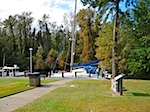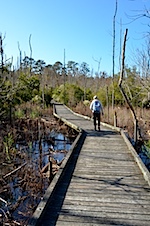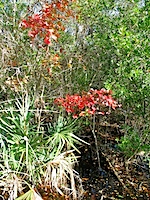After a wonderful stay in Williamsburg, we pulled up stakes and headed south. Good old Route 17 led us around Newport News, across the James River Bridge, down towards Portsmouth, and thankfully, west of Norfolk.
Traveling down the Colonial Parkway (connecting Jamestown, Williamsburg and Yorktown) you pass great long piers running out into the York River where we saw two of what appeared to us to be Bath-built destroyers tied up to the pier.
It turns out the west side of the York is the Naval munitions depot, a place that runs well back into early American history. If you look at this area in Google Maps you’ll see the depot encompasses an enormous piece of land; certainly as your drive though it on the Parkway it is heavily wooded and it doubtless has huge expanses of forest which are home to a lot of wildlife. It’s one more of those ironies: that military reservations should, in their need for secrecy and isolation, protect vast parts of the country against the kind of development that might otherwise adversely impact the wildlife native to the area.
We crossed into North Carolina, our FIRST really new state (we’d been to Mt. Vernon, Arlington, and other suburbs of DC before this trip). We were looking for a tourist information center and were not disappointed. A couple of miles south of the line, there it was, and they had the maps and information we wanted. What was more fun was the way the center was situated: it was right off Route 17, and right on the edge of the Intracoastal Waterway; on the west side of the parking area were docks for boaters on the ICW.

When we walked into the center, the woman asked if we were off a boat – you get an idea of how seedy (or yacht-y, take your pick) we were looking! The ICW here runs down the eastern edge of the Great Dismal Swamp for many miles, and sure enough, there were sailboats and powerboats streaming south. Interestingly, this section of the ICW was originally developed as a canal to connect Chesapeake Bay with Albemarle Sound in 1805. As usual, the history quickly got more complicated.
We ended this leg at Elizabeth City for lunch, where there were a few ICW’ers tied up to wait out the Northeaster that was full of rain.

We spent the next two nights in Historic Bath, North Carolina, with a side trip to Washington and New Bern, NC, and to Goose Creek State Park.
The highlights of Historic Bath were:
- The astonishing variety of historic signs in the town.
- The menu at one of the local restaurants (where the vegetable side dishes on offer were: salad, slaw, mac salad, potato salad, baked potato, apple sauce).
- The young newlyweds at breakfast: he from NJ, she from next door, Washington, NC; really nice people, having just done the big family wedding and off on their honeymoon to Cancun. It turned out she had just graduated from Brooklyn Law School, and while she hadn’t been lucky enough to have Katie’s old classmate and great friend and much-missed SLC classmate, the late Eve Cary, as a prof., she had heard wonderful things of Eve’s continuing activities at BLS, even after she stopped teaching. It warmed our hearts to talk with them, not something that always happens when you have breakfast with strangers!
We took a wander on a well-done boardwalk in Goose Creek State Park, and while the season wasn’t the best for wildlife viewing, we did manage to find a Yellow-Rump Warbler and a hairy woodpecker.
Bath had a small marina with a lot of undistinguished plastic clorox bottles in it, but it had also been homeport to a gorgeous old 66 ft. Herreshoff cutter, Margaret (more here), which had been carried ashore when her chain broke during hurricane Irene. We hope the owner finds the means to get her afloat soon; there has apparently been looting on her since the accident.
During the two days we spent in the Bath area there was a steady NE wind blowing, and we noticed how high the tide was along many of the rood that were near the creeks and bays. In Washington, we visited the Estuarium, an excellent museum and information center devoted to education and outreach on the issues related to estuaries, and in this case, the Pamlico Sound. It is an extremely well-done effort. In the process, we asked them what the normal range of the tide is in the Sound and were fascinated to learn that because the barrier islands so effectively insulate the Sound from ocean tides, it is the wind which controls what appears to be tide: a strong easterly drives the Sound water up into the rivers and creeks; a westerly drains them out and piles up the water against the barrier islands, and in the case of really strong westerlies, cause a splash-over from the inside of the barrier islands into the ocean. The changes in water level can be a matter of many feet. Certainly, while we were in New Bern, we found a couple of the low-lying street along the shore partly flooded due to the easterly wind.
Found in New Bern, a beautiful old buy boat from the Chesapeake, which looked to me to have fallen on hard times. 
Sunday, 6 November, we headed for Manteo, on Roanoke Island. We took NC 264, along the south side of the peninsula, via Englehard. If you look at the map, you see towns listed on the map, but this has to be one of the most monotonous, isolated places we’ve seen in a while. The land is seriously FLAT, as in western Kansas flat, and the crops are pine trees (for pulp and paper), cotton, and soy beans; no stores, no restaurants, no gas stations – it was impressive.
We stopped at the Mattamuskeet National Wildlife Refuge hoping to see some of the 20 – 30,000 Tundra Swans which winter over there, but the wind was blowing hard; if the swans were there they were sheltered out of sight. But we did find a beautiful Great White Egret: 
Lake Mattamuskeet turns out to be the largest natural lake in NC, with a fortunately failed history of attempts to drain it and farm it!
Our other stop was at Swan Quarter (that’s the town’s name; look it up!). It is home to an impressive array of shrimp and oyster draggers, all of which seemed to be tied up and many of which looked unready to go to sea.
We rolled into Manteo, found our delightful hotel, and are settled in for a week.





Post a Comment